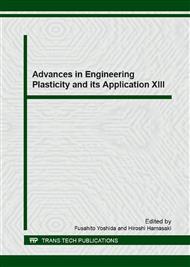p.249
p.255
p.261
p.267
p.275
p.281
p.287
p.293
p.299
Thermo-Mechanical Cyclic Plastic Behavior of 304 Stainless Steel at Large Temperature Ranges
Abstract:
Thermo-mechanical cyclic experiments on 304 stainless steel were performed at several temperature ranges which had maximum temperatures ranging from 350°C to 1000°C and a minimum temperature of 150 °C. Related isothermal cyclic experiments were also performed. Temperature-history dependent cyclic hardening significantly occurred under thermo-mechanical cyclic loading with maximum temperatures around 600°C, whereas almost no cyclic hardening was observed when the maximum temperature was 1000°C. The observed thermo-mechanical cyclic plastic behavior in the saturated state of cyclic hardening was then simulated using a cyclic viscoplastic constitutive model, leading to the following findings. It was difficult to predict the saturated thermo-mechanical cyclic behavior using only the isothermal cyclic experimental data. The saturated thermo-mechanical cyclic behavior was simulated well by introducing a cyclic hardening parameter depending on the maximum temperature. This means that the cyclic hardening parameter should not change with temperature but depend on the maximum temperature in the saturated state of cyclic hardening under thermo-mechanical cyclic loading.
Info:
Periodical:
Pages:
275-280
Citation:
Online since:
December 2016
Authors:
Price:
Сopyright:
© 2017 Trans Tech Publications Ltd. All Rights Reserved
Share:
Citation:


